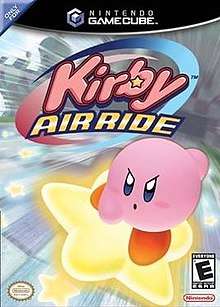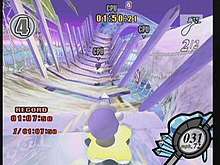Kirby Air Ride
Kirby Air Ride, known in Japan as Kirby's Airride (カービィのエアライド, Kābī no Earaido), is a 2003 racing video game developed by HAL Laboratory and published by Nintendo for the GameCube video game console starring Kirby.
| Kirby Air Ride | |
|---|---|
 North American cover art | |
| Developer(s) | HAL Laboratory |
| Publisher(s) | Nintendo |
| Director(s) | Masahiro Sakurai |
| Producer(s) | Hiroaki Suga Masayoshi Tanimura Shigeru Miyamoto |
| Artist(s) | Kazuya Konishi |
| Composer(s) | Shogo Sakai Jun Ishikawa Hirokazu Ando Tadashi Ikegami Akira Miyagawa |
| Series | Kirby |
| Platform(s) | GameCube |
| Release | |
| Genre(s) | Racing |
| Mode(s) | Single-player, multiplayer |
Kirby Air Ride has the players and computer-controlled racers ride on Air Ride Machines. The game supports up to four players, and was the first GameCube title to support LAN play using broadband adapters and up to four GameCube systems.
Air Ride received a mixed reception from critics, who criticized the game's simplicity. The game was a commercial success, selling over 1.2 million copies worldwide.
Gameplay
Kirby Air Ride is played primarily through use of a vehicle, many of which are taken from previous Kirby games, such as the Warpstar. Players take control of Kirby or any of his multicolored counterparts to compete in races or other minigames.
The simple controls are a defining feature of Kirby Air Ride. Unlike most racers, no input is necessary for the craft to move forward. Other than the use of the Control Stick to steer, the A button performs all other actions in the game, including braking, charging up for a boost, sucking in nearby enemies and thereafter using the powers absorbed from them.[1] Gliding is also a definitive feature of the game, as the player can control the crafts' altitude when they go airborne.[2]
Each of the three modes of the game has a "checklist" associated with it. These are 12x10 grids which contain 120 squares, all of which are initially blank. Each square has a hidden goal contained inside it, and certain goals also have unlockable content attached to them, such as alternate machines, new items and courses, new characters, and music tracks for the sound test. When a goal is completed, the squares fill to reveal completed goals. In practice, this system of discovering unknown goals is balanced out by several goals which are relatively easy to obtain, such as "finish a race three times" or "race on every course," and various other goals which only require the accrual of play time; these, in turn, make it easier to find out what other, more specific goals are, since each goal unlocked will open up the objective of the goals touching the goal completed.
Kirby is the only playable character available from the start of the game, and the only one who can ride different machines and suck up enemies to copy their abilities. Multiple players are represented by different colors of Kirby. Meta Knight, Kirby's rival, is an unlockable character. He doesn't ride machines, but instead uses his wings to float above the ground. He controls like a combination of Wing Kirby and Sword Kirby, as he uses sword attacks automatically when he approaches enemies or other players. Because he has high speed and acceleration in the game, he cannot charge. King Dedede is also unlockable. Controlling him is almost exactly like using the Wheelie Bike, except he can attack automatically with his hammer, similar to Meta Knight's attack.
Modes of play

- Air Ride
Air Ride is a basic, back-view racing mode. The player chooses a racing machine and races against up to three other human or computer players via split-screen or LAN to get to the finish before anyone else. There are two ways to play a typical Air Ride race:
- Laps: Laps is the default mode, where the player finishes the race by completing a set number of laps around the course. The number of laps can be custom set from 1 to 99, or kept at the track's default. The default number of laps may depend on the current course.
- Time: In Time mode, players race for a set amount of time, and the player that goes the farthest down the track wins the match.
In both modes, the Kirbys may swallow and acquire the abilities of enemies strewn along the track and use those powers against their rivals. Doing so will slow Kirby's enemies down and potentially do damage to them (if the Health Bar is activated for the race.) In addition to the racing mode, Air Ride also has the option of Time Attack mode, where a single player races around a track for three laps.[3] Lastly, a single player can also race Free Run mode, an endless race with the sole purpose of reaching the fastest possible Lap Time.[4]
- Top Ride
Top Ride is a racing mode on smaller, simpler tracks, and is viewed from above the track. Due to the decreased track size, the default number of laps is increased per track. Top Ride has only two vehicles to choose from; the red Free Star moves in the direction the Control Stick is tilted, while the blue Steer Star rotates clockwise or counterclockwise based on tilting the Control Stick right or left.[5] Like Air Ride, Top Ride also has Time Attack and Free Run modes. There are seven courses total, based on seven different themes: Grass, Sand, Sky, Fire, Light, Water and Metal.[6]
- City Trial
City Trial is a larger mode where players must navigate a city, along with several more sections such as a forest, cave, and volcano, while grabbing Air Ride machine upgrade items, such as boosts, top speeds, charges, offense, defense, and more. Various Air Ride vehicles are randomly scattered throughout the city, allowing the player to switch vehicles at any time in the game. Players can even collect rare machine pieces to fuse together into a "Legendary Air Ride Machine," either the Dragoon or the Hydra. This mode also features random events such as falling meteors, UFOs, Dyna Blade, rail station fires, bouncing items, fake power-ups, a strange pillar, a thief, all boxes containing the same items, dense fog, and more. When time expires, players face off in a small competition that tests how well your machine ended up, which can vary between a drag race, a brawl, a contest to destroy the most enemies, a gliding game, and even a lap on one of the Air Ride courses.[7]
Development
Kirby Air Ride (known as Kirby Bowl 64 or Kirby Ball 64 at the time; Kirby Bowl is the Japanese name for Kirby's Dream Course) was originally in development during the early days of the Nintendo 64 video game console.[8] It was one of only two playable demos shown at the Nintendo 64's unveiling at the 1995 Shoshinkai show (the other being Super Mario 64).[9] At this point the game consisted of two sub-games.[10] One was somewhat similar to Marble Madness, as players would control a ball-shaped Kirby to either race across an obstacle course (in single player) or knock competing players off the playing field (in multiplayer).[11] The other more closely resembled the final game: a snowboarding race in which Kirby collects stars for points.[10] It went through many changes during its elongated development period (the version shown at the 1996 E3 resembled a skateboarding sim[12]) before eventually being canceled and then resurfacing on the GameCube in the form of a short video preview in March 2003 at the annual DICE summit in Las Vegas, at which point it received its final title. This preview received a mainly negative reception due to slow speeds and poor graphics, factors which the Kirby Bowl 64 prototype had also been criticized for.[13]
Kirby Air Ride was first seen in playable form at E3 in May later that year. The demo contained five playable tracks and three different game modes. The reception to this playable demo was more positive than the video preview.
Masahiro Sakurai, the game designer behind most of the early games in the Kirby series, resigned from his position at HAL Laboratory shortly after the game's release, citing that he was tiring of the constant pressure from the industry to keep creating sequels.[14][15]
Music
The soundtrack was composed by Shogo Sakai, Jun Ishikawa, Hirokazu Ando, and Tadashi Ikegami. Three of those composers also worked on Super Smash Bros. Melee.
Kirby Air Ride features songs from the Japanese version of Kirby: Right Back at Ya! (the game was also advertised at the end of some episodes).
Reception
| Reception | ||||||||||||||||||||||||||||||
|---|---|---|---|---|---|---|---|---|---|---|---|---|---|---|---|---|---|---|---|---|---|---|---|---|---|---|---|---|---|---|
| ||||||||||||||||||||||||||||||
Kirby Air Ride sold 422,311 copies in Japan and 750,000 in the United States.[26][27] Upon its release, the game received mixed reviews according to the review aggregator website Metacritic.[16] Most websites and magazines praised its clean presentation, music, and the originality of the City Trial mode while criticizing its gameplay as being overly simple. Kirby Air Ride's similarity to other titles released for the GameCube around the same time (most notably F-Zero GX and Mario Kart: Double Dash, both of which were also made by Nintendo) resulted in it being categorized as a rather throwaway title.[23] In Japan, Famitsu gave it a score of two eights and two nines for a total of 34 out of 40.[19]
References
- Kirby Air Ride Instruction Booklet pg. 8-11
- Casamassina, Matt (October 13, 2003). "Kirby Air Ride". IGN. Retrieved October 5, 2016.
- CocoA VorteX (2003). "Kirby Air Ride - General FAQ". IGN.
- Kirby Air Ride Instruction Booklet pg. 13-19
- Kirby Air Ride Instruction Booklet pg. 20-24
- Kirby Air Ride Instruction Booklet pg. 37
- Kirby Air Ride Instruction Booklet pg. 25-31
- Murphy, Mark (August 26, 2003). "Kirby Air Ride". Gamers Europe. Archived from the original on June 14, 2006. Retrieved November 29, 2006.
- Semrad, Ed (February 1996). "Ultra 64 Unveiled" (PDF). Electronic Gaming Monthly. No. 79. Sendai Publishing. p. 6.
- "Kirby Bowl 64". GamePro. No. 90. IDG. March 1996. p. 23.
- "Kirby Bowl 64". Next Generation. No. 14. Imagine Media. February 1996. p. 53.
- "E3: Kirby's Air Ride". GamePro. No. 95. IDG. August 1996. p. 32.
- IGN staff (March 4, 2003). "Kirby's Air Ride: First Look". IGN. Retrieved October 5, 2016.
- Bryer, Glen (October 5, 2005). "HAL Laboratory: Company Profile (Conceiving Sickeningly Cute Puffballs)". N-Sider.com. Retrieved October 5, 2016.
- "Masahiro Sakurai". N-Sider.com. Archived from the original on January 8, 2016. Retrieved November 29, 2006.
- "Kirby Air Ride for GameCube Reviews". Metacritic.
- Edge staff (September 2003). "Kirby Air Ride". Edge (127).
- EGM staff (November 2003). "Kirby Air Ride". Electronic Gaming Monthly (172): 196. Archived from the original on January 6, 2004. Retrieved October 5, 2016.
- "Famitsu, Dengeki and Dorimaga scores". Rage3D. July 9, 2003. Retrieved October 5, 2016.
- Helgeson, Matt (December 2003). "Kirby Air Ride". Game Informer (128): 158. Archived from the original on April 3, 2008. Retrieved October 5, 2016.
- The D-Pad Destroyer (October 14, 2003). "Kirby Air Ride Review for GameCube on GamePro.com". GamePro. Archived from the original on February 9, 2005. Retrieved October 5, 2016.
- Silverman, Ben (October 2003). "Kirby Air Ride Review". Game Revolution. Retrieved October 5, 2016.
- Gerstmann, Jeff (October 15, 2003). "Kirby Air Ride Review". GameSpot. CNET Networks. Retrieved October 5, 2016.
- Williams, Bryn (October 15, 2003). "GameSpy: Kirby Air Ride". GameSpy. Retrieved October 5, 2016.
- "Kirby Air Ride". Nintendo Power. 174: 139. December 2003.
- "Nintendo Gamecube japanese ranking". Japan Game Charts. July 20, 2007. Archived from the original on April 9, 2008.
- Edge staff (July 29, 2006). "The Top 100 Games of the 21st Century". Edge. Archived from the original on April 26, 2012. Retrieved October 5, 2016.
External links
- Kirby Air Ride at Nintendo.com (archives of the original at the Internet Archive)
- Kirby Air Ride at MobyGames